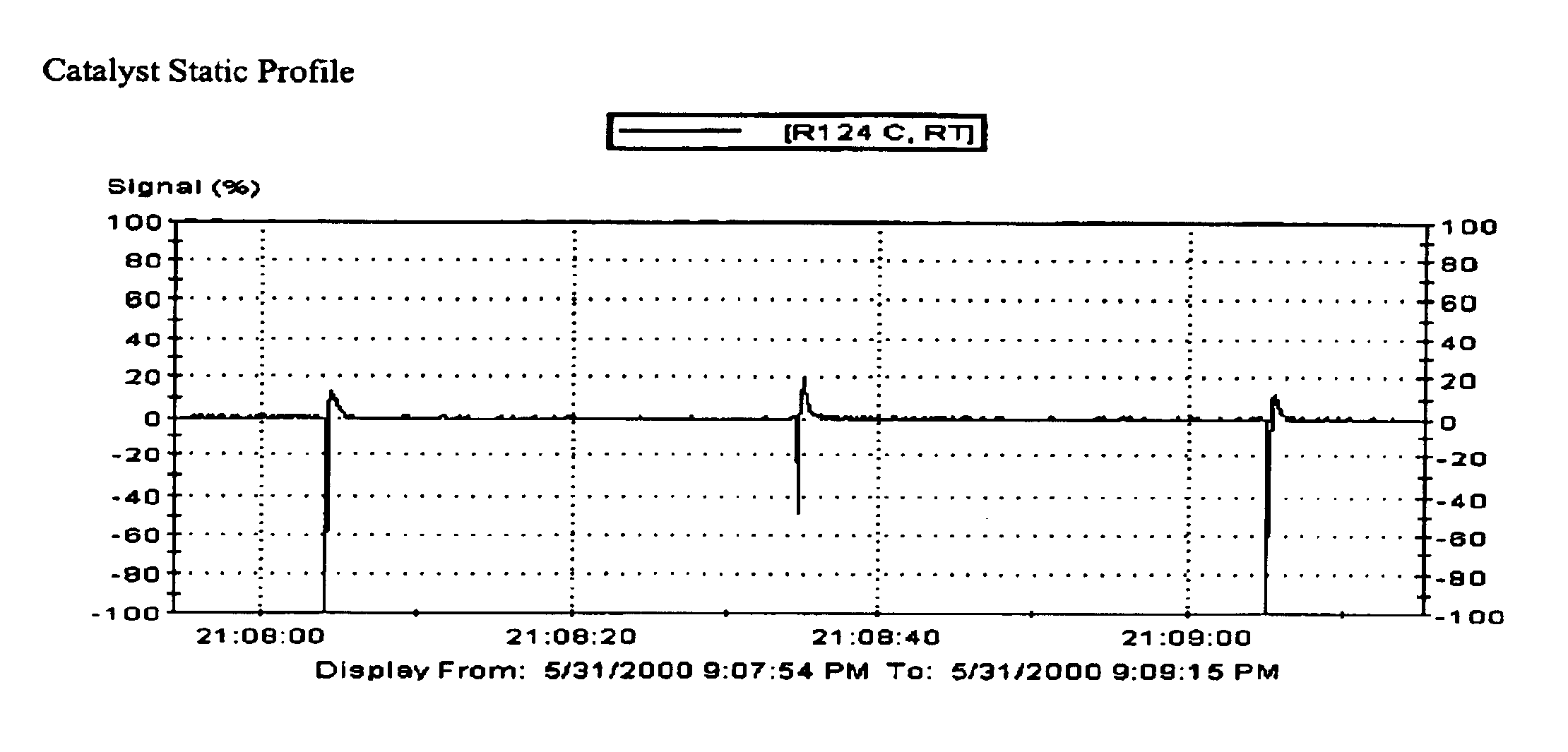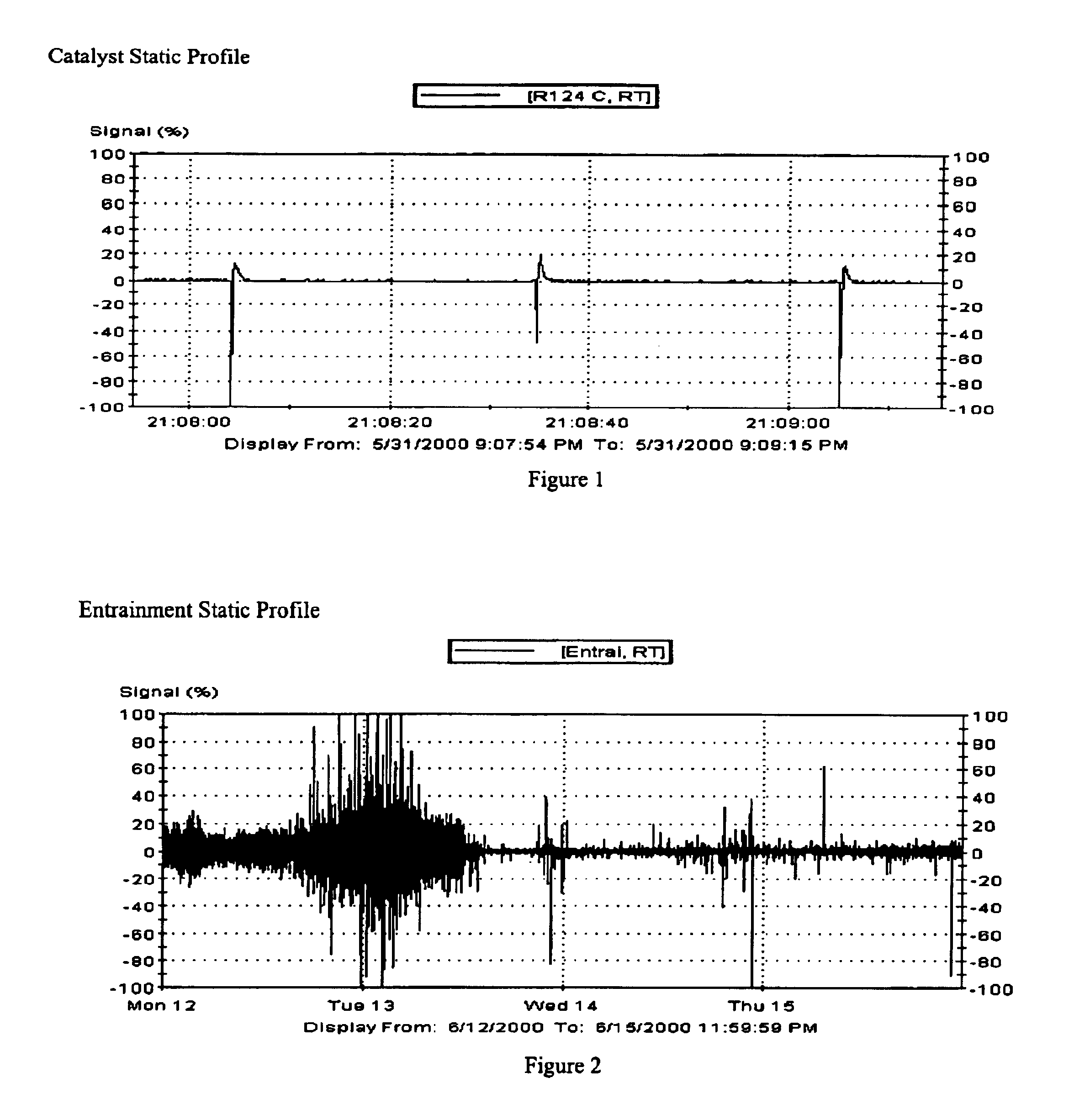Polymerization reactor operability using static charge modifier agents
a technology of static charge modifier and polymerization reactor, which is applied in the direction of physical/chemical process catalysts, catalyst activation/preparation, chemical/physical processes, etc., can solve the problems of ineffectiveness of most known static charge modifiers, and achieve the effect of improving the condition of static charge build-up and sheeting, and reducing the static attraction of resin and/or catalys
- Summary
- Abstract
- Description
- Claims
- Application Information
AI Technical Summary
Benefits of technology
Problems solved by technology
Method used
Image
Examples
example 1
Synthesis of [N(C18H37)4] [B(C6H5)4]
[0134]Starting Materials:
65.17 g [(n-C18H37)4N]Br+51.25 g LiB(C6F5)4 (Et2O)2.5
[(n-C18H37)4N]BrMW1107.9
LiB(C6F5)4 (Et2O)2.5 MW871.3
[0135]In dry box, 65.17 g of [(n-C18H37)4N]Br and 51.25 g of LiB(C6F5)4 (Et2O)2.5 were added into a flask. 300 mL. methylene chloride was added and the mixture was stirred for 1.5 hrs. Most of solvent may be removed by assisted evaporation with dry nitrogen. Approximately 400-500 mL. pentane is added. The resulting mixture is filtered through Celite until the filtrate is clear. This is then filtered through a 0.45 micron filter. The pentane is removed by assisted evaporation, followed by drying of the white solid product [N(C18H37)4] [B(C6H5)4] (hereinafter, AB-1) under vacuum. The product may be characterized by 1H and 19F-NMR.
[0136]The tetraalkylammonium borate salt [N(C18H37)4] [B(C6H5)4] (AB-1) used in this study was already under evaluation as a modifier or adjuvant molecule in solution polymerizations. The salts ...
example 2
Preparation of Catalyst With the Tetrakis (Octadecyl) Ammonium Tetrakis (penta-fluoro-phenyl) Boron Static Charge Modifier
[0137]In a dry box purged with dry nitrogen, two one-liter bottles were charged with 29.93g and 29.92g of tetrakis (octadecyl) ammonium tetrakis (penta-fluoro-phenyl) boron described above. To each bottle, 900 mL. of dried hexane was added. The bottles were sealed and removed from the dry box.
[0138]The solutions were then cantered onto 1.75 kg of dry, silica supported dimethylsilyl (tetrahydroindenyl) zirconium dichloride and alumoxane in a sealed glass reactor equipped with a stirrer. An additional 700 mL. of dry hexane was added to form a paste-like slurry. This was gently stirred and dried under nitrogen purge at 100° F. (3° C.) for approximately 5 hours. The dried catalyst weighed 1.8 kg. The boron / zirconium stoichiometry was 0.95.
[0139]The catalyst then prepared was used in the polymerization reported in Example 3.
example 3
Fluid-Bed Polymerization
[0140]The polymerization was conducted in a continuous gas phase fluidized bed reactor. The fluidized bed is made up of polymer granules. The gaseous feed streams of ethylene and hydrogen together with liquid comonomer were mixed together in a mixing tee arrangement and introduced below the reactor bed into the recycle gas line. Hexene was used as comonomers. The individual flow rates of ethylene, hydrogen and comonomer were controlled to maintain fixed composition targets. The ethylene concentration was controlled to maintain a constant ethylene partial pressure. The hydrogen was controlled to maintain a constant hydrogen to ethylene mole ratio. The concentration of all the gases were measured by an on-line gas chromatograph to ensure relatively constant composition in the recycle gas stream.
[0141]The solid catalyst was injected directly into the fluidized bed using purified nitrogen as a carrier. Its rate was adjusted to maintain a constant production rate....
PUM
| Property | Measurement | Unit |
|---|---|---|
| particle size | aaaaa | aaaaa |
| particle size | aaaaa | aaaaa |
| particle size | aaaaa | aaaaa |
Abstract
Description
Claims
Application Information
 Login to View More
Login to View More - R&D
- Intellectual Property
- Life Sciences
- Materials
- Tech Scout
- Unparalleled Data Quality
- Higher Quality Content
- 60% Fewer Hallucinations
Browse by: Latest US Patents, China's latest patents, Technical Efficacy Thesaurus, Application Domain, Technology Topic, Popular Technical Reports.
© 2025 PatSnap. All rights reserved.Legal|Privacy policy|Modern Slavery Act Transparency Statement|Sitemap|About US| Contact US: help@patsnap.com



